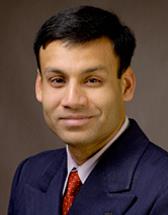Mechanics of Blood Clots and Fluctuating Lipid Bilayers
Speaker: Professor Prashant Purohit, University of Pennsylvania
Date: Sep 15, 2017; Time: 2:00 pm Location: UTEB 175
 Abstract: Blood clots are required to stem bleeding and are subject to a variety of stresses, but they can also block blood vessels and cause heart attacks and strokes. We measured the compressive response of human platelet-poor plasma (PPP) clots, platelet-rich plasma (PRP) clots and whole blood clots and correlated these measurements with confocal and scanning electron microscopy to track changes in clot structure. Stress-strain curves revealed four characteristic regions, for compression-decompression: 1) linear elastic region; 2) upper plateau or softening region; 3) non-linear elastic region or re-stretching of the network; 4) lower plateau in which dissociation of some newly made connections occurs. Our experiments revealed that compression proceeds by the passage of a phase boundary through the clot separating rarefied and densified phases. This observation motivates a model of fibrin mechanics based on the continuum theory of phase transitions, which accounts for the pre-stress caused by platelets, the adhesion of fibrin fibers in the densified phase, the compression of red blood cells (RBCs), and the pumping of liquids through the clot during compression/decompression. Our experiments and theory provide insights into the mechanical behavior of blood clots that could have implications clinically and in the design of fibrin-based biomaterials. As a second topic we will consider thermal fluctuations of lipid bilayer membranes. Typically, membrane fluctuations are analyzed by decomposing into normal modes or by molecular simulations. We propose a new approach to calculate the partition function of a membrane. We view the membrane as a fluctuating elastic plate and discretize it into triangular elements. We express its energy as a function of nodal displacements, and then compute the partition function and covariance matrix using Gaussian integrals. We recover well-known results for the dependence of the projected area of the membrane on the applied tension and recent simulation results on the dependence of membrane free energy on geometry, spontaneous curvature and tension. As new applications, we compute elastic and entropic interactions of inclusions in membranes.
Abstract: Blood clots are required to stem bleeding and are subject to a variety of stresses, but they can also block blood vessels and cause heart attacks and strokes. We measured the compressive response of human platelet-poor plasma (PPP) clots, platelet-rich plasma (PRP) clots and whole blood clots and correlated these measurements with confocal and scanning electron microscopy to track changes in clot structure. Stress-strain curves revealed four characteristic regions, for compression-decompression: 1) linear elastic region; 2) upper plateau or softening region; 3) non-linear elastic region or re-stretching of the network; 4) lower plateau in which dissociation of some newly made connections occurs. Our experiments revealed that compression proceeds by the passage of a phase boundary through the clot separating rarefied and densified phases. This observation motivates a model of fibrin mechanics based on the continuum theory of phase transitions, which accounts for the pre-stress caused by platelets, the adhesion of fibrin fibers in the densified phase, the compression of red blood cells (RBCs), and the pumping of liquids through the clot during compression/decompression. Our experiments and theory provide insights into the mechanical behavior of blood clots that could have implications clinically and in the design of fibrin-based biomaterials. As a second topic we will consider thermal fluctuations of lipid bilayer membranes. Typically, membrane fluctuations are analyzed by decomposing into normal modes or by molecular simulations. We propose a new approach to calculate the partition function of a membrane. We view the membrane as a fluctuating elastic plate and discretize it into triangular elements. We express its energy as a function of nodal displacements, and then compute the partition function and covariance matrix using Gaussian integrals. We recover well-known results for the dependence of the projected area of the membrane on the applied tension and recent simulation results on the dependence of membrane free energy on geometry, spontaneous curvature and tension. As new applications, we compute elastic and entropic interactions of inclusions in membranes.
Biographical Sketch: Prashant Purohit is currently Associate Professor in the Department of Mechanical Engineering and Applied Mechanics at the University of Pennsylvania. He got his PhD at Caltech in 2002 studying martensitic phase transitions in solids. His current interest is in problems at the intersection of mechanics, physics and biology. Of particular interest are problems in which thermal fluctuations, or entropy, plays a significant role in the mechanics. Examples of such problems include DNA phase transitions, fluctuating filaments and networks and the mechanics of lipid bilayers. Prashant has also worked on nanomechanics of flexoelectric solids and carbon nanotube foams.